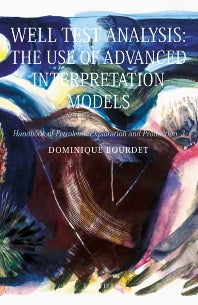Freshly Printed - allow 10 days lead
Couldn't load pickup availability
Well Test Analysis
The use of Advanced Interpretation Models
Dominique Bourdet (Author)
9780444509680, Elsevier Science
Hardback, published 21 August 2002
438 pages
24 x 16.5 x 2.8 cm, 0.98 kg
This book on well test analysis, and the use of advanced interpretation models is volume 3 in the series Handbook of Petroleum Exploration and Production.The chapters in the book are: Principles of Transient Testing, Analysis Methods, Wellbore Conditions, Effect of Reservoir Heterogeneities on Well Responses, Effect of Reservoir Boundaries on Well Responses, Multiple Well Testing, Application to Gas Reservoirs, Application to Multiphase Reservoirs, Special Tests, Practical Aspects of Well Test Interpretation.
Preface. 1. Principles of Transient Testing. 1.1 Introduction. 1.2 Typical flow regimes. 1.3 Well and reservoir characterization. 2. The Analysis Methods. 2.1 Log-log scale. 2.2 Pressure curves analysis. 2.3 Pressure derivative. 2.4 The analysis scales. 3. Wellbore Conditions. 3.1 Well with wellbore storage and skin. 3.2 Infinite conductivity or uniform flux vertical fracture. 3.3 Finite conductivity vertical fracture. 3.4 Well in partial penetration. 3.5 Slanted well. 3.6 Horizontal well. 3.7 Skin factors. 4. Effect of Reservoir Heterogeneities on Well Responses. 4.1 Fissured reservoirs. 4.2 Layered reservoirs with or without crossflow. 4.3 Composite reservoirs. 4.4 Combined reservoir heterogeneities. 5. Effect of Reservoir Boundaries on Well Responses. 5.1 Single sealing fault in a homogeneous reservoir. 5.2 Two parallel sealing faults in homogeneous reservoir. 5.3 Two intersecting sealing faults in homogeneous reservoir. 5.4 Closed homogeneous reservoir. 5.5 Constant pressure boundary. 5.6 Communicating fault. 5.7 Effect of boundaries in double porosity reservoirs. 5.8 Effect of boundaries in double permeability reservoirs. 5.9 Effect of boundaries in composite reservoirs. 5.10 Other boundary configurations. 5.11 Conclusion. 6. Multiple Well Testing. 6.1 Interference tests in reservoirs with homogeneous behavior. 6.2 Factors complicating interference tests in reservoirs with homogeneous behavior. 6.3 Interference tests in composite reservoirs. 6.4 Interference tests in double porosity reservoirs. 6.5 Interference tests in layered reservoirs. 6.6 Pulse testing. 6.7 Conclusion. 7. Application to Gas Reservoirs. 7.1 Description of gas wells pressure behavior. 7.2 Practical transient analysis of gas welltests. 7.3 Deliverability tests. 7.4 Field example. 8. Application to Multiphase Reservoirs. 8.1 Perrine's method. 8.2 Pseudo-pressure method. 8.3 Pressure squared method. 9. Special Tests. 9.1 DST. 9.2 Impulse test. 9.3 Constant pressure test, and rate decline analysis. 9.4 Vertical interference test. 10. Practical Aspects of Well Test Interpretation. 10.1 Factors complicating well test analysis. 10.2 Interpretation procedure. 10.3 Well and reservoir characterisation- interpretation results. Appendix 1. Summary of Usual Log-Log Responses. Appendix 2. Practical Metric System of Units. Nomenclature. References. Author Index. Subject Index.
Subject Areas: Environmental science, engineering & technology [TQ], Petroleum technology [THFP], Fossil fuel technologies [THF], Economic geology [RBGL], Mining industry [KNAT]


